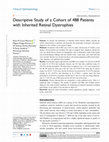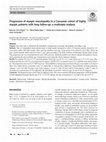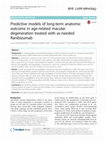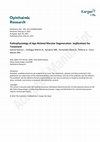Papers by Maria Rosa Sanabria
Journal of Clinical Medicine, Mar 20, 2023
This article is an open access article distributed under the terms and conditions of the Creative... more This article is an open access article distributed under the terms and conditions of the Creative Commons Attribution (CC BY
PubMed, 2003
Clinical cases: We report two cases of SO (sympathetic ophthalmia) among 1,456 vitrectomies and 2... more Clinical cases: We report two cases of SO (sympathetic ophthalmia) among 1,456 vitrectomies and 255 silicone oil injections performed since 1990. In both patients intraocular silicone oil was used. Both cases were clinically documented and one pathologically demonstrated. Discussion: No cases were reported among vitrectomies without silicone oil. We found a longer delay between injury and the onset of the disease in comparison to the literature. Pathological findings confirmed a foreign body granulomatous reaction. Chronic inflammation caused by silicone oil might be involved in the development of SO. Larger series are necessary to establish a possible relationship between silicone oil and SO.

Archivos De La Sociedad Española De Oftalmología (english Edition), 2016
Objective: To review the problems found after a new follow-up protocol for patients on chloroquin... more Objective: To review the problems found after a new follow-up protocol for patients on chloroquine and hydroxychloroquine treatment. Method: Retrospective study was conducted between May 2012 and January 2013 on the clinical files, retinographies, fundus auto-fluorescence (FAF) images, and central-10 degree visual fields (VF) of patients who were referred to the Ophthalmology Department as they had started treatment with hydroxychloroquine. Results: One hundred twenty-six patients were included; 94.4% were referred from the Rheumatology Department and 5.6% from Dermatology. Mean age was 59.7 years, and 73.8% were women. All of them were on hydroxychloroquine treatment, and 300 mg was the most frequent daily dose. Rheumatoid arthritis was the most common diagnosis (40.5%), followed by systemic lupus erythematosus (15.9%). The mean Snellen visual acuity was 0.76, and 26 patients had lens opacities. The VF were normal in 97 patients, 8 had mild to moderate defects with no definite pattern, and in 9 the results were unreliable. Of the 51 patients older than 65 years, 16 (31.4%) had altered or unreliable VF. The FAF was normal in 104 patients (82.5%), and abnormal, but consistent with ophthalmoscopic features, in 12 patients (pathological myopia, age related changes, early, middle or late age-related macular degeneration). Conclusions: Visual fields as a reference test for the diagnosis of AP toxicity are not quite reliable for patients over 65. Therefore, the FAF is recommended as primary test, perhaps combined with another objective test, such as SD-OCT instead of VF.

Archivos de la Sociedad Española de Oftalmología, 2016
Evaluar el protocolo implantado en nuestro hospital para el cribado de toxicidad ocular por antip... more Evaluar el protocolo implantado en nuestro hospital para el cribado de toxicidad ocular por antipalúdicos (AP) revisando las características de los pacientes estudiados y los problemas encontrados tras su implantación. Método: Estudio retrospectivo de las historias clínicas, retinografías, fotos de autofluorescencia (FAF) y campos visuales (CV) centrales 10-2 de los pacientes que iban a iniciar tratamiento con AP, desde el momento de la implantación del protocolo en mayo de 2012 hasta enero de 2014. Resultados: Se han revisado 126 pacientes. El 94,4% procedían del servicio de reumatología y el 5,6%, del de dermatología. La edad media fue de 59,7 años, y el 73,8% fueron mujeres. Todos estaban en tratamiento con hidroxicloroquina, siendo la dosis más frecuente 300 mg diarios. La artritis reumatoide fue el diagnóstico más frecuente (40,5%), seguido del lupus eritematoso (15,9%). La agudeza visual media fue de 0,76; 26 pacientes presentaban opacidades de cristalino. En 97 pacientes los CV resultaron normales, 8 presentaron defectos leves o moderados sin patrón definido, y en 9 los resultados fueron poco fiables. De los 51 pacientes mayores de 65 años, 16 (31,4%) presentaron CV alterados o no valorables. La FAF resultó normal en 104 pacientes (82,5%) y anormal, aunque congruente con los hallazgos oftalmoscópicos, en 12 pacientes. Conclusiones: El rendimiento de los CV como test de referencia para el diagnóstico de toxicidad por AP es relativamente bajo en pacientes mayores de 65 años. Por ello creemos recomendable usar la FAF como test primordial y asociarlo quizás a otro test objetivo, como el SD-OCT, en detrimento de los CV.
Drugs & Aging, Apr 29, 2022

Clinical Ophthalmology, 2021
Purpose: To analyze the distribution of inherited retinal diseases (IRDs), describe the clinical ... more Purpose: To analyze the distribution of inherited retinal diseases (IRDs), describe the clinical characteristics of patients, and determine the percentages of patients with genetic diagnosis in the Castilla y Leon region of Spain. Methods: All patients with an IRD seen in the two major referral units of Castilla y Leon during a 20-year period were included. The ages at symptom onset, diagnosis, and the last visit; sex; family history; history of consanguinity; type of inheritance; status of the fundus and electroretinogram findings; lens and macular status, visual acuity; and visual field data were recorded. Patients were divided into those with retinitis pigmentosa (RP) and all others. Gene mutations were gathered when available. Results: Four hundred eighty-eight patients with IRDs were studied: 216 (44.26%) with RP of which 34 (15.74%) had syndromic diseases, and 272 had other conditions being 161 (59,19%) macular dystrophies. The mean delay in diagnosis was 6-16.2 years respectively. For the RP group the mean age at the last visit was 47.96±17,26; mean age of cataract surgery was 48.30 ± 12.01 years; and the foveal area was preserved in 74 (35.07%) patients, atrophic in 101 (47.87%), and edematous in 36 (17.06%). A genetic study had been performed in 58 (26.85%) of patients with RP and 71 (26,1%) of the rest, being indeterminate in 17 (29.31%) out of RP group and 20 (28.16%) out of the others. Conclusion: Clinical characteristics are comparable to other published series. There is a significant delay in diagnosis. The number of patients with IRDs and available genetic diagnosis, thus being possible candidates for undergoing personalized treatments including gene therapy in our region is low and must be improved.
Investigative Ophthalmology & Visual Science, 2013
Investigative Ophthalmology & Visual Science, 2015

Backgorund: To analyze the distribution of inherited retinal diseases (IRDs), describe the clinic... more Backgorund: To analyze the distribution of inherited retinal diseases (IRDs), describe the clinical characteristics of patients, and determine the percentages of patients with genetic diagnoses in the Castilla and Leon region of Spain.Methods: All patients with an IRD seen in the two major referral units of Castilla y Leon during a 20-year period were included. The ages at symptom onset, diagnosis, and the last visit; sex; family history; history of consanguinity; type of inheritance; status of the fundus and electroretinogram; lens and macular status, visual acuity; and visual field data were recorded. Patients were divided into those with retinitis pigmentosa (RP) and all others. The genetic mutations were gathered.Results: Four hundred eighty-eight patients with IRDs were studied, 216 with RP (of which 15.74% had syndromic disease) and 272 with other conditions (59.19% of which were macular dystrophies). A genetic study had been performed in 27.31% of patients (29.31% of which we...
Investigative Ophthalmology & Visual Science, 2008
Arquivos Brasileiros de Oftalmologia, 2021

Graefe's Archive for Clinical and Experimental Ophthalmology, 2020
Purpose This study aims to determine the probability of progression of myopic maculopathy accordi... more Purpose This study aims to determine the probability of progression of myopic maculopathy according to age. Methods This is a longitudinal observational study of single-center retrospective cohort of Caucasian patients formed by 212 consecutive adults with high myopia. Main outcome measures were age, visual acuity (VA), refractive error (RE), follow-up time, and the macular status assessed at least 5 years apart according to the Meta-Analysis of Pathologic Myopia Study Group. The progression rate was calculated based on per 1000 eyes/year. Multistate models were fitted to identify the predictive factors and to calculate the most probable age of progression onset using the Aalen-Johansen estimator. Results We studied 220 eyes of 122 Caucasian patients. Mean age was 48.18 ± 14.1, mean follow-up 12.73 ± 5.81 years. Onehundred and fifty-two (69.1%) eyes progressed of category, and 96 (44%) worsened a mean of 0.3 logMAR units during followup. The progression rate was 32.21/1000 eyes/year. The probability of progressing increased with age; it was higher in women if there was a family history of myopia, worse VA, higher RE, or wide macular staphyloma. The probability of progressing from category 1 was > 0.6 after 70 years of age; from category 2, it was 0.7 after 70 years; and 0.5 from category 3 after 75 years. If choroidal neovascularization (CNV) appeared, this probability exceeded 0.7 between ages 45 and 55 for all categories. Conclusion The progression rate is lower than in a Japanese series. The vision worsened with disease progression, and the probability of both happening increased after the age of 70-75. If CNV appears, the risk of progression is very high at the age of 45-55.

European Journal of Ophthalmology, 2010
Purpose. To assess the occurrence of PRPH2 mutations in patients presenting macular dystrophies a... more Purpose. To assess the occurrence of PRPH2 mutations in patients presenting macular dystrophies and to describe their phenotype-genotype correlation. Methods. A total of 32 sporadic cases and 13 individuals from 5 families were studied. The patients presented early onset drusen, suspected pattern dystrophy (including adult-onset foveomacular vitelliform dystrophy [AOFVD]), or any presumed macular dystrophy producing neovascularization or atrophic changes documented before patients reached 50 years of age. In case of atrophy, this could be confined to the macula, which was considered to be central areolar choroidal dystrophy (CACD), or extend to the midperiphery of the retina, which we called diffuse macular dystrophy (DMD). Clinical workup and analysis of PRPH2, EFEMP1, and TIMP3 genes were done. Results. Four mutations of the PRPH2 gene were found in 3 sporadic cases and 3 families (n=11). A p.R46X mutation, previously described in CACD, was found in 3 members of a family with AOFV...

BMC Ophthalmology, 2017
Background: To analyze predictors and develop predictive models of anatomic outcome in neovascula... more Background: To analyze predictors and develop predictive models of anatomic outcome in neovascular age-related macular degeneration (AMD) treated with as-needed ranibizumab after 4 years of follow-up. Methods: A multicenter consecutive case series non-interventional study was performed. Clinical, funduscopic and OCT characteristics of 194 treatment-naïve patients with AMD treated with as-needed ranibizumab for at least 2 years and up to 4 years were analyzed at baseline, 3 months and each year until the end of the follow-up. Baseline demographic and angiographic characteristics were also evaluated. R Statistical Software was used for statistical analysis. Main outcome measure was final anatomic status. Results: Factors associated with less probability of preserved macula were diagnosis in 2009, older age, worse vision, presence of atrophy/fibrosis, pigment epithelium detachment, and geographic atrophy/fibrotic scar/neovascular AMD in the fellow eye. Factors associated with higher probability of GA were presence of atrophy and greater number of injections, whereas male sex, worse vision, lesser change in central macular thickness and presence of fibrosis were associated with less probability of GA as final macular status. Predictive model of preserved macula vs. GA/fibrotic scar showed sensibility of 77.78% and specificity of 69.09%. Predictive model of GA vs. fibrotic scar showed sensibility of 68. 89% and specificity of 72.22%. Conclusions: We identified predictors of final macular status, and developed two predictive models. Predictive models that we propose are based on easily harvested variables, and, if validated, could be a useful tool for individual patient management and clinical research studies.
BMC Ophthalmology, 2014
Background: The study aims to survey longstanding funduscopic and functional outcomes of age-rela... more Background: The study aims to survey longstanding funduscopic and functional outcomes of age-related macular degeneration (AMD) after ranibizumab treatment and verify the accuracy of a new method to compare the retinal thickness measured with different optical coherence tomography (OCT) tools. Methods: Case series included 314 eyes with 2-4 years of follow-up. Main Outcome Measures were visual acuity (VA), number of injections, retinal thickness, OCT morphology, and final macular funduscopic status. Results: One hundred twenty-two men and 177 women (mean age, 78.3 years) were included. The mean time to the first injection was 17.3 ± 14.6 days. Initial VA was O.8(20/125

Optometry and Vision Science, May 1, 2018
SIGNIFICANCE The present study provides quantitative data regarding the change of indications of ... more SIGNIFICANCE The present study provides quantitative data regarding the change of indications of fluorescein angiography in a tertiary hospital. Exhaustively compiled data over more than 10 years concerning all the angiographic studies including diagnosis, first-visit/follow-up, possible relation with antiangiogenics approval, and optic coherence tomography (OCT) are presented. PURPOSE The aim of this study was to determine the frequency and indications of fluorescein angiography before and after OCT and anti-vascular endothelial growth factor (anti-VEGF) treatment implantation. METHODS This was a retrospective and descriptive study of all fluorescein angiographies performed in a tertiary hospital between 2005 and 2016. Demographic data, diagnosis, follow-up, and type of angiograms were analyzed in relation with the implantation of time domain OCT (2006), spectral domain OCT (SD-OCT) (2013), and anti-VEGF (2007). RESULTS Of 3263 angiograms (2342 patients) analyzed, 72% were baseline angiograms, and 28% were follow-up angiograms. After anti-VEGF initiation, the number of angiograms per year increased progressively with peaks that matched with the approval of anti-VEGF for wet age-related macular degeneration (2007) (164.2%), macular edema secondary to retinal vein occlusions (2010) (102.2%), and diabetic macular edema (2011) (123.8%). After using SD-OCT, fluorescein angiographies decreased up to 57%. CONCLUSIONS Anti-VEGF introduction led to an increase in the indication of angiograms, which did not vary significantly after time domain OCT. Nevertheless, since SD-OCT became available, the indication of fluorescein angiography has halved in the hospital of reference.

Background: Uniform postresidency systems to train medical specialists have not been developed in... more Background: Uniform postresidency systems to train medical specialists have not been developed in most European countries. Before developing a framework for such a system, we established the learning and professional profiles of Spanish ophthalmologists dedicated to medical retina and vitreoretina subspecialties. Methods: After identification of presumed subspecialists by experts from different autonomous regions, a self-administered questionnaire was mailed in 2006. A reminder was sent three weeks later. Postal mail was used. Nonresponder bias was determined. Results: Of 492 possible retina subspecialists, 261 replied to the questionnaires. While about 86 % received specific retinal training, standardized fellowship programs were uncommon for both medical retina and vitreoretina (around 10%). Of the responders, 24.5 % performed only medical retina, 11.8 % vitreoretina, and 63.6 % both. Most (60.5%) practiced anterior segment surgery, and 78.7 % declared skills in vitrectomy. Conclu...

Ophthalmic Research
Age-related macular degeneration (AMD) is a complex, multifactorial, progressive retinal disease ... more Age-related macular degeneration (AMD) is a complex, multifactorial, progressive retinal disease that affects millions of people worldwide and has become the leading cause of visual impairment in developed countries. The disease etiopathogenesis is not understood fully, although many triggers and processes that lead to dysfunction and degeneration of the retinal pigment epithelium (RPE) already have been identified. Thus, the lack of cellular control of oxidative stress, altered proteostasis, dysfunction of lipid homeostasis, and mitochondrial dysfunction form an internal feedback loop that causes the RPE to fail and allows accumulation of abnormal misfolded proteins and abnormal lipids that will form drusen. An inadequate antioxidant response, deficits in autophagy mechanisms, and dysregulation of the extracellular matrix (ECM) help to increase the deposition of abnormal drusen material over time. The drusen then act as inflammatory centers that trigger chronic inflammation of the ...

Ophthalmology, 2010
To assess the genetic contribution to proliferative vitreoretinopathy (PVR) and report the strong... more To assess the genetic contribution to proliferative vitreoretinopathy (PVR) and report the strong association observed in the tumor necrosis factor (TNF) locus. As a component of The Retina 4 Project, a case-controlled, candidate gene association study in the TNF locus was conducted. Blood from 450 patients with (138 cases) and without (312 controls) post-rhegmatogenous retinal detachment (RD) PVR was genotyped to determine polymorphisms located in the TNFα gene. Single nucleotide polymorphisms (SNPs) with correlation coefficients of ≥ 0.8 and a minor allelic frequency of ≥ 10% were studied. Functional SNPs or SNPs previously described in association with other inflammatory diseases were also added for analysis. The SNPlex Genotyping System (Applied Biosystems, Foster City, CA) was used for genotyping. Single nucleotide polymorphism and haplotype analyses were performed. Bioinformatic tools were used to evaluate those SNPs that were significantly associated. Single and haplotypic significant associations with PVR. A total of 11 common tag SNPs in the following genes were analyzed: lymphotoxin alpha (LTA), TNFα, leukocyte-specific transcript 1 (LST1), and the activating natural killer receptor p30 (NCR3). After permutation, there was a significant association in the non-synonymous polymorphism rs2229094(T→C) in the LTA gene (P = 0.0283), which encodes a cysteine to arginine change in the signal peptide. This marker was also present in all significant haplotypic associations and was not observed in any nonsignificant associations. When this SNP was analyzed using bioinformatic tools, the hydropathy profile changed, as well as the transmembrane region and the splicing site predictions. The strong association found in the rs2229094(T→C) of the LTA gene may indicate an important role of this polymorphism in the development of PVR. If supported in extended studies, the rs2229094(T→C) may have significant implications regarding the genetic risk of the retinal repairing process.








Uploads
Papers by Maria Rosa Sanabria